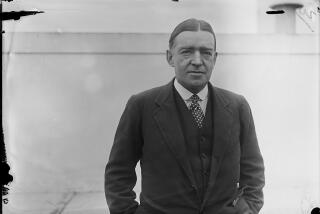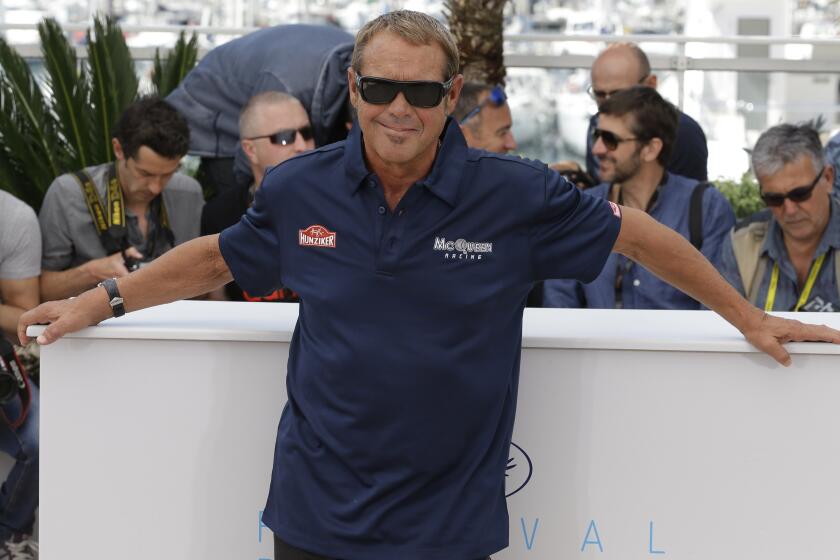Eugene Wilkinson dies at 94; Nautilus skipper pioneered nuclear sub era
As the boat moved down the channel into Long Island Sound, the captain ordered a message sent ashore that forever changed the strategy of naval warfare: “Underway on nuclear power.”
With those words on the morning of Jan. 17, 1955, Cmdr. Eugene Wilkinson signaled that Nautilus, the Navy’s first nuclear-powered submarine, a bold and technically complex project, was a success.
The primacy of diesel-powered submarines, forced to surface regularly and thus vulnerable to counterattack, was over. Future U.S. submarines would be nuclear.
With its onboard reactor, the Nautilus could stay submerged almost indefinitely and could move faster than any diesel submarine. It could detect and strike an enemy before the foe knew what was happening.
In the middle of the Cold War, with the U.S. and Soviet Union vying for dominance at sea, Nautilus “was definitely a game-changer,” said Lt. Cmdr. Benjamin Amdur, director of the Submarine Force Museum near Groton, Conn., where the Nautilus is now a floating museum.
Wilkinson, Amdur said, receives much of the credit. “He’s our Neil Armstrong,” someone who went where no one had gone before and helped America beat the Soviets in a race for prestige and scientific prowess.
A World War II hero who became an executive in the civilian nuclear industry after retiring from the Navy, Wilkinson died July 11 at his home in Del Mar. He was 94.
Wilkinson proved adept at navigating the tricky engineering challenges of nuclear propulsion and the prickly personality of Adm. Hyman Rickover, the “father” of the nuclear Navy.
He remained Nautilus’ first captain for two more years, then moved on to serve as commanding officer of a nuclear-powered surface ship, the guided-missile ship Long Beach. Promoted to vice admiral, he held several important commands before retiring in 1974 as deputy chief of naval operations for submarine operations.
At the Navy’s submarine school at New London, Conn., one of the main buildings is Wilkinson Hall. His example is held up as an exemplar of leadership: charismatic, fair, decisive, Amdur said.
Eugene Parks Wilkinson was born Aug. 10, 1918, in Long Beach. After his father died in a car accident and his mother from illness, he lived with his grandparents in the Imperial Valley, where they ran a creamery.
He enrolled at then-San Diego State College with the intent to study medicine. Instead he studied chemistry and physics and received his degree in 1938 at age 19. He then spent an additional two years on campus teaching chemistry and mathematics while doing course work toward a doctorate at USC.
In 1940, he enlisted in the Navy, received an officer’s commission and served for a year on the cruiser Louisville before being assigned to submarine school.
Sent to the Pacific, Wilkinson deployed on eight combat patrols, including on the submarine Darter at the Battle of Leyte Gulf, the largest naval battle of World War II.
The Darter attacked the Japanese fleet with gusto in an effort to prevent it from advancing on the invasion force of Gen. Douglas MacArthur. It launched “one of the greatest torpedo shoots of World War II,” including sinking the heavy cruiser Maya and striking other enemy ships before being forced heavily aground, according to Navy historians.
For his role in leading the daring attack, Wilkinson was awarded a Silver Star for valor, a rarity for a junior officer.
The battle marked Wilkinson as an officer destined for advancement and, after the war ended, he was assigned to Rickover’s nuclear reactor project in Oak Ridge, Tenn., and then sea duty as commanding officer of the submarines Volodor, Sea Robin and Wahoo before joining the Nautilus project in 1953.
His selection as the first commanding officer of Nautilus had a surprising element. He was a graduate of a then-obscure state college, not the Naval Academy like many senior officers.
Wilkinson sometimes liked to gently poke at his peers who were Annapolis alums, telling them that graduation from such a prestigious institution made them more interested in tradition than innovation.
While given to spreading the congratulations to his crew, he was rightly proud of what Nautilus accomplished.
“Remember it took the Navy 50 years to shift from sail to steam,” he liked to say, “and they changed to nuclear overnight.”
When some initial problems occurred, Wilkinson stood up to the doubters. The brilliant but ever-impatient Rickover would call and begin yelling in his squeaky voice, “What? What? What the hell are you talking about?”
In retirement, Wilkinson saw the humor in the situation. “You know, new construction, it all leaks a little at first,” he once said.
In 1979, after the accident at the Three Mile Island nuclear power plant, Wilkinson was asked by industry leaders to take the lead in devising safety standards. The result was the creation of the Institute of Nuclear Power Operations.
Wilkinson is survived by sons Dennis, Stephen and Rod; daughter Marian Casazza; and four grandchildren. His wife, Janice, died in 2000.
He is to be buried at Fort Rosecrans National Cemetery in Point Loma.
More to Read
Start your day right
Sign up for Essential California for the L.A. Times biggest news, features and recommendations in your inbox six days a week.
You may occasionally receive promotional content from the Los Angeles Times.






